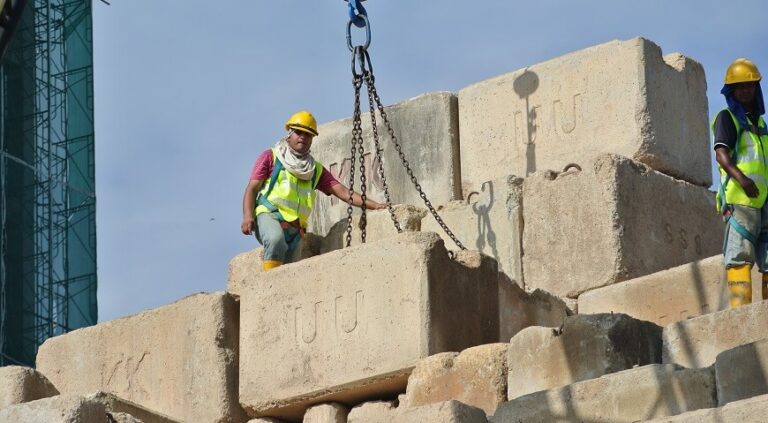Understanding Load-Bearing Capacity for Concrete Barriers

As suppliers of premium concrete blocks and barriers for construction sites and engineering projects across the UK, Maltaward is often asked – does the load-bearing capacity of concrete barriers matter?
It’s an important question. When implementing robust perimeter protection measures on your site, you need assurance the chosen barriers can withstand operational wear, environmental elements, and potential impacts without failing.
At Maltaward, we provide durable concrete barriers designed and tested to handle heavy loads while keeping sites, assets, and people safe and secure. Read on for professional guidance on assessing concrete barrier load capacities.
What Factors Influence Concrete Barrier Strength?
Several variables affect the load-bearing capabilities of concrete products like barriers, blocks, and bollards:
- Concrete Grade – Concrete is rated on a scale from C10 to C60, indicating its designed compressive strength in megapascals (MPa). Higher grades from C40 upwards are typically used for structural load-bearing masonry work and heavy civil applications.
- Reinforcement – Steel reinforcement bars (rebars) integrated into concrete add tensile strength to handle flexing and impacts. Hollow blocks – often lighter than solid concrete blocks – often require steel reinforcement and can work in a load-bearing capacity.
- Concrete Density – Heavier, thicker concrete can manage greater surface loads without cracking or crumbling. They are typically more difficult to handle than more hollow or less dense blocks but often add greater stability in upholding structural integrity.
- Dimensions – A barrier’s length, height and width impact total load capacity based on sheer mass. Wider jersey concrete barrier bases especially improve stability.
Considering these variables, we formulate commercial-grade concrete barriers to handle heavy loads while remaining portable via special equipment and machinery. Let’s explore more specifics on barrier strength ratings.
Load Bearing Capacities by Barrier Type
Our concrete barriers are designed in compliance with British Standard EN 1317 to tolerate significant uniformly distributed loads without fracturing or overturning.
Jersey Barriers
With slender profiles enabling quick installation and reconfiguration, jersey barriers have moderate load handling.
- These are manoeuvrable 1500kg concrete barriers.
- They are made from high-strength precast concrete (50N/mm2).
These would be suitable as car park dividers, roadside barriers, security access perimeters and crowd control.
Whether buying or hiring, we can supply precast concrete jersey barriers nationwide with prompt delivery.
TVCBs (Temporary Vertical Concrete Barriers)
TVCBs can be installed where heavy-duty barrier protection is required. These barriers and bollards come in a variety of sizes and configurations, but as a loose guide:
- Each block weighs 2.5 tonnes.
- They can be bolted together to add extra resilience.
- They are also made from resilient precast concrete (50N/mm2).
Their versatile design with interlocking capabilities makes them easily configurable and can manage traffic and people, as well as loads, fairly comfortably. Entrusting shear loads to them should be considered by consulting concrete barrier supplies like Maltaward, who can guide proper installation and configuration.
Kentledge Concrete Blocks
Kentledge blocks (otherwise known as hoarding or kelly blocks) may not be as heavy as TVCBs or jersey barriers, coming only in either half-tonne or full-tonne maximums.
However, their expanded surface area (1030x750x750 for 1-tonne blocks, and 1025x430x580 for 0.5-tonne blocks) makes them suitable products as anchors. They provide secure anchorage for scaffolds while also making them ideal counterweights on cantilevered structures. They are made using high-strength concrete (50N/mm2), thus giving them tremendous resilience for all types of downward pressure.
Are Interlocking Concrete Blocks Load-Bearing?
Load-bearing capacity is a vital consideration that engineers must take into account before any construction begins. The foundation must be able to handle a certain amount of weight and no more, whether it’s a temporary wall or a multi-storey building.
Interlocking concrete barriers are load-bearing, to some degree. The configuration of the groups of concrete blocks will undoubtedly make them capable of handling certain weights. As weight is evenly spread across more interlocked concrete barrier stacks, each block will be able to tolerate more downward pressure.
However, using a higher load than what interlocking blocks can bear will result in instability and affect structural resilience. Therefore, it’s vital to ensure that any subsequent construction work is not placing too much pressure on blocks, even if multiple ones are installed in unison.
Optimise Site Protection with Our Concrete Barriers and Blocks
While this overview explores some factors to consider when exploring loads for concrete bollards and barriers, total product capacities can’t be summarised by basic metrics alone.
Custom security requirements, environmental conditions, foundation preparations, and certified testing procedures all impact real-world functionality. That’s why Maltaward goes beyond conjectures to deliver rigorously tested defensive concrete products suitable for your specific needs.
Maltaward stands ready to fulfil any complex concrete load-bearing prerequisites to help developers meet project milestones without compromising safety. To request guidance from our in-house safety experts, contact us today.










